Rebatching Soap – What is it and why would I do it? – Rebatching is another form of cold process soapmaking. You can either make cold process soap from scratch or buy a premade base, grate it up, place it over a heat source, either in a double boiler or in a freezer baggie as shown below, with a little liquid (water, beer, milk, teas all work well). This mixture “melts” down into a mushy mess that you add colorant and fragrance too. The reason people normally rebatch is to preserve the delicate scent or the healing properties of some essential oils.
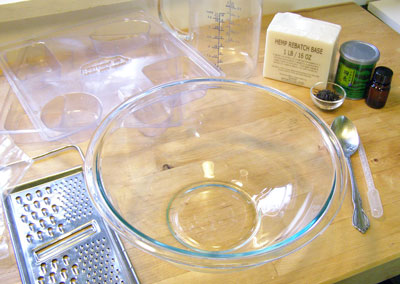
Rebatching Soap (make it yourself or buy a premade base)
Fragrance or Essential Oil
Mold (the less detail, the better)
Optional: Herbs
Colorant (liquid works best)
Freezer Bags (must must must be heat safe)
Grater
Large Bowl
Spoon
Step One: Grate the soap. I’ve tried a variety of things (food processor, meat grinder, deli meat slicer) and all of the cutters have gummed up on me and not worked after a few ounces worth of soap grinding. If you have any great tips, please post them here and save us some time and arm soreage.
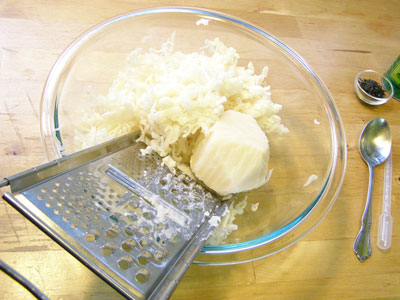
Step Two: Bring a large pot of water to boil. Fill a freezer bag (heat safe) with the grated soap and approximately 1/2 to 1 ounce of liquid. Submerge the freezer bag of soap in the boiling water. Be sure to use a large enough pot that the freezer baggie will not be squished up against the side of the pot. You don’t want to accidentally melt the plastic baggie.
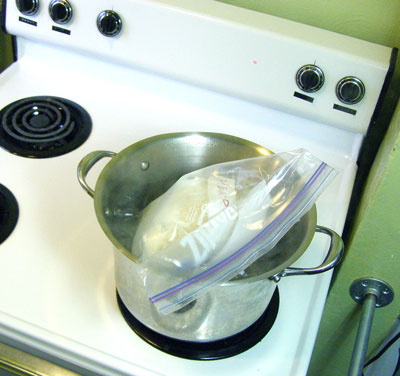
Step Three: Once the soap has boiled in the large pan for approximately 20 minutes, the soap should be gelatinous and gloppy, sort of like mashed potatoes or thick soupy oatmeal. It will never “melt” and become water like.
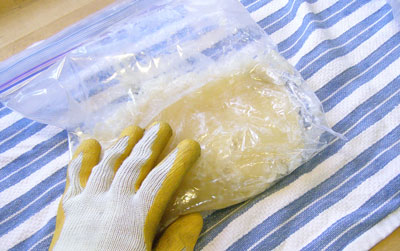
Step Four: Using heat safe gloves (that soap is hot! wear gloves!), pull the soap out of the water. Knead it around to make sure the liquid is fully mixed into the soapy gloppy glory. Is it too thick? Add another 1 Tablespoon of liquid if needed and knead this into the soap. The key is to not use very much liquid. The more liquid you add to this process, the thinner the soap gets (true) but the longer it will take to dry and harden.
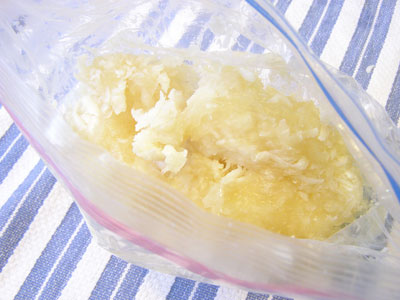
Step Five: The photo above shows the soap midway through the softening process. It’s not perfect yet. Put that soap back into the boiling water.
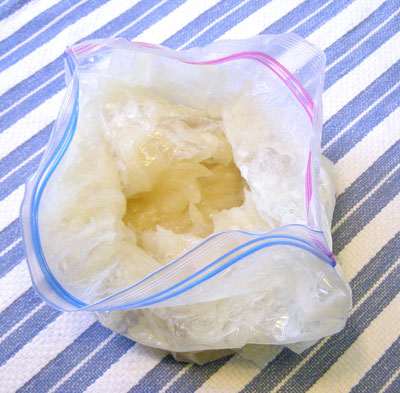
Step Six: The photo above is perfect texture. It looks like thick Vaseline. It is now ready for the color and fragrance.
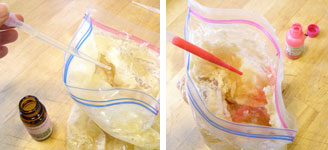
Step Seven: Add fragrance and color. Liquid color is ideal (mixing pigments into the gloppy soap is difficult). I use approximately .5 ounces of fragrance or essential oil per pound of soap. The colorant usage varies based on the color but start sparingly. You can always put more color in but taking it out is difficult. If the soap starts to harden up at any point because it is cooling, reseal the bag and toss it all back into the hot water. Make sure you wear heat safe gloves through this entire process. The soap is hot.
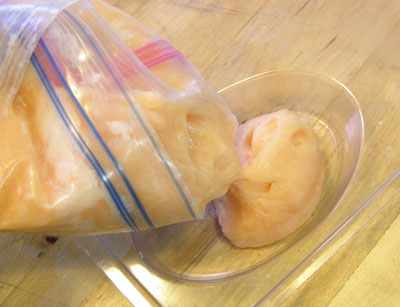
Step Eight: You can either spoon the soap into the molds or pour/push/squeeze the soap out of the baggie. Unless you are an experienced rebatch soaper, I would not recommend cutting off a corner of the bag to squeeze the soap out like frosting. It’s tempting but if the soap starts to cool too quickly, the open hole will not allow you to remelt the soap in the boiling water.
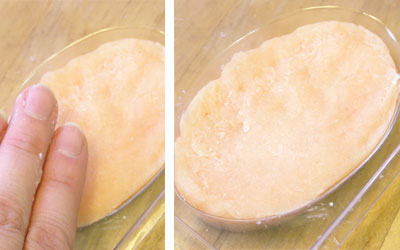
Step Nine: Take the mold you are using, close your eyes and give it a good wack on the counter to settle the soap and get all the air bubbles to the surface of the bar. When the soap starts to cool, feel free to use your hands and fingers to smooth out any bumps on the surface.
Wait for 2 to 7 days before popping the soap out. The key is to wait for all the liquid to evaporate. Yes, you can become impatient and freeze the soap but make sure the soap is entirely frozen (overnight at least) before trying to pop the soap out and remember that plastic is more brittle after it is frozen so be gentle on your molds.
Check back in the next few days for a tutorial on how to do rebatching soap via the double boiler method. This is my favorite way to do rebatch and you can do larger batches with the double boiler method.
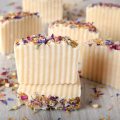
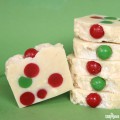
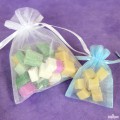
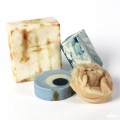
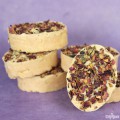
Great! Thanks for the reply on this. Greatly appreciate it!
Just wondering if anyone has used food coloring in their rebatched soap, or even CP soap, and how it worked out.
Thanks.
Hi Natasha!
We typically don’t use food coloring in our soap because we have found that they are not as stable as our other colorants, and they do tend to bleed when used in bath and body products. But, if you really want to use them and you don’t mind having the bleeding effect in your soaps, you can use them (they do work particularly well with the gloppy texture of rebatch soaps).
-Becky with Bramble Berry
I just made a batch of soap with a new fragrance which I should have tested because it seized up immediately after adding the fragrance. I scooped it into the mold anyways and unveiled it today. It’s a big oily mess with tons of craters. Can I rebatch this or just throw it out. I have not done a rebatch yet.
Good morning, Charlene! You can totally rebatch your soap since it didn’t turn out how you’d like. You can follow this method, or here are a few other methods to rebatch your soap:
How to Make Rebatch Soap: http://www.soapqueen.com/bath-and-body-tutorials/cold-process-soap/soap-queen-tv-presents-how-to-make-rebatch-soap-2/
Rebatch – Double Boiler Method: http://www.soapqueen.com/bath-and-body-tutorials/rebatch-double-boiler-method-2/
Last Minute Project for Mom!: http://www.soapqueen.com/bath-and-body-tutorials/cold-process-soap/mothers-day-is-sunday-last-minute-project/
Green Tea Rebatch: http://www.soapqueen.com/bath-and-body-tutorials/cold-process-soap/green-tea-rebatch-teabatch/
I hope this helps!
-Becky with Bramble Berry
The plastic bag method for rebatching soap has my attention. Are their certain bags that say on them (heat resistant)? What kind do you buy
Good morning, Corky!
The best heat resistant bags that we’ve found to use for this sort of rebatch are going to be the name-brand freezer bags that you’d find at your local grocery store! 🙂
-Becky with Bramble Berry
Hi there,
I recently made a batch of milk soap with a heavy cream–it got so think when I added the lye I could not easily tell if the lye had fully dissolved.
Unfortunately–turns out the lye DIDN’T fully dissolve. There aren’t large “pockets” of lye–just individual crystals that didn’t dissolve from the lye flakes.
Can I rebatch this soap? Do I just need to take extra care kneading the bag to make sure the lye reacts? Or do I need to pitch this batch?
I would LOVE to save it–so any help is great, thanks!!
To be extra safe, you should probably pitch it. I’m sorry =((( I’m wondering about turning it into laundry soap though? Grate it up, dry it out and see if you could at least not waste it that way?
Hello — I’m new to this site, and wanted to say that I have heard that folks are having no end of trouble with those 6 or 7 quart crock pots that have the 4-6-8-10 hours settings: they super-heat stuff. The low setting isn’t really low, either.
Welcome to Soap Queen, Rosemari! All crock pots are a bit different in their settings. My suggestion would be to always keep an eye on your soap to make sure you don’t burn or scorch it and don’t let your soap get over 160 degrees.
I don’t actually have a microwave, so I use my crock pot and my handy-dandy mini temperature gun to make sure that my soap is staying in a safe range.
https://www.brambleberry.com/Mini-Temperature-Gun-P4848.aspx
-Becky with Bramble Berry
Can you use the melt and pour soap base to grate up and rebatch?
Rebatch is a beginners form of cold process soapmaking where you grate up pre-made Cold Process soap. Melt and Pour is kind of like using a cake mix, it’s a pre-made soap base that you can melt in the microwave and customize with colorants and fragrance oils.
Here are two great videos that show the difference between the two techniques:
Melt and Pour: http://www.youtube.com/playlist?list=PL05E2F1EF0838281A&feature=plcp
Rebatch: http://www.youtube.com/watch?v=2YcCV0AWutw&list=UUStN08hkQ1321WVdFqWD2-w&index=27&feature=plpp_video
And here’s a link to the rebatch bases if you are interested in making cold process soap without handling lye: https://www.brambleberry.com/Search.aspx?k=rebatch
-Becky with Bramble Berry
Danigi, Those are great suggestions and observations. Yes, the soap is softer on the sides that aren't exposed to air because they can't/don't evaporate their extra moisture so turning them is great.
Anon,
Coconut Oil makes soap harder when you're making soap from scratch. Added afterwards to rebatching soap will actually make a softer bar because there is no lye to bind with it and make it hard.
Your soap will continue to get harder over the next few weeks. I'm so glad that you like rebatching. I'm a big fan of it too.
Did you see the SoapQueen.TV episode on it?
http://www.youtube.com/watch?v=2YcCV0AWutw
It's a different method and works better for larger batches. =)
I just made my first batch of rebatched soaps last night. I usually make the melt and pour soaps for years.
I love how the soaps turned out except that the bars are way to soft. so I will be adding coconut oil next time so that the bars will be harder. and I will also add less liquid too. super fun!
I use a cheese grater and use the next to biggest size on it. It works wonderfully. I am in the process of rebatching a batch of soap for yet a third time because it didnt come out right when I rebatched it the first time. The original soap came out fine but I had forgotten to add teatree oil. So I rebatched it and have been fighting with it ever since. I have my own soapmaking business, and I am hoping that this will harden up soon. I have learned that one of the ways to harden up a batch pf rebatched soap is to not cover it, just let it sit out in the open for a couple days, then take it out, cut it, and put it on a cooling rack to dry. Make sure you turn the soap bars over so they are now sitting on their "tops" because the "bottoms" will be MUCH softer. Anyway, just a few ideas to throw in there. I have melted down soap in the microwave and it came out fine. You have to turn the power setting on the microwave down from Hi to about 60% heat. It works really well for small batches.
Definitely you can use wooden molds – just make sure to line them.
I just did a video on doing rebatching soap that you can view here:
http://soap-queen.blogspot.com/2010/02/soap-queen-tv-presents-how-to-make.html
I use a wooden mold in there =)
Hope this isn't a silly question, but I've read about people using plastic molds for re-batching soap, but haven't seen anyone mention a wood mold. Can you use wood molds for making re-batched soap?
Just make your CP batch like normal and toss in as much of the grated soap as your soap will take – use a fragrance that won't accelerate trace so you have plenty of time to mix in the soap chunks.
Don't remelt the soap – add in the grated honey soap like confetti bits to your new batch of CP sap =)
How do you mix it in with other batches. What is the calculations for this as to not mess up the CP process with the additions. What is the best way to melt it down again as the crock was to hot for the honey?
Yup its the honey, I did the same things a few years ago ended up grating and adding it to several other batches 😉
So the soap might have been left in too long – that's the first thing I'd be looking at. But if that's not the case, the other theory I have is that it's the honey. The honey is trouble in normal CP soap recipes without the added heat. It super gels and super heats up all by itself and then with the crockpot heat added, that could have also crystallized and burnt the sugars in the honey.
Yes, you can melt it down again but it won't improve things. I would just use the soap up or grate it up and put it into a normal CP batch with a sweet fragrance like Vanilla (which is going to go brown anyways).
Soap mistakes happen to the best of us. Your recipe would have been awesome without the honey. =)
The exact recipe was:
4 pounds
– 38 ounces olive oil (59.38%)
– 14.4 ounces Apricot Kernel (22.5%)
– 11.6 ounces palm oil (18.13%)
– 8.7 ounces sodium hydroxide (5% discount)
– 17.5 ounces distilled water
– 3 ounces rosemary mint blend essential oils
4 oz of honey
I placed it in a crock pot on low after mixing all the ingredients. My crock pot is a 6qt with the settings of 4-6-8-10 hr settings.
It turned into a big ugly glob and was difficult to stir put in the fragrance and honey at the end and place in mold, very difficult to get it to settle into the mold. then let it sit all day. did not cover or place blankets as that was not mentioned in the recipe.
When I removed the molds it was just a weird consistancy and molds not good as it did not completley pick up the design. so I broke it up and put it in crock pot again. I grated it in a food processor and placed all my other shavings of old cold processed soap with it and placed it on low setting. Let it melt over approx 3 hours. then placed them in the same molds as before. but still unable to add fragrance as it was too gooey and globby and hot again. think it was scalded??? hard to tell but black stringy stuff init when it was hot. Haven't removed them yet from the molds. Any suggestions? If this doesn't work what next? Can it be melted down again?
Hi Kellie –
A failed batch is never fun.
What was your exact recipe? You combined everything, brought it to trace and then put the crockpot on Medium and waited for it to come to the nice Vaseline-stage? Did you actually add honey? How much?
I just tried a crock pot soap recipe that was mostly olive oil ran the numbers thru the lye calc and placed the crock on low as directed.. the soap came out aweful and smelled as burned honey and turned brown. I crushed the soaps up and rebatched them with some other scraps of CP soaps and added 3oz of water to each pound of soap and cooked in crock for 3 hours on low. It had the goooo consistancy and was hot. couln't add Fragrance as it was so thick and hot and it to smelled burnt. So just placed in molds and now waiting wondering OMG another failure… Can this be salvaged.. How do I make it smell good? Not so sure honey was the right thing to do??
Yay! I'm so glad that you were able to have a successful batch using these recipes and instructions. I have a SoapQueen TV episode coming out this year that utilizes the double boiler for rebatching.
Thank you for posting this Anne-Marie! I was actually in the studio today and tried my hand at rebatching before realizing I didn't know what to do!!! LOL So, I immediately started thinking and remembered you posting something about rebatching. Well…5 minutes later I was finished reading your blog and feel like it's time to head back into the studio. Thank you.
With rebatching soap, you can re-use all of your kitchen utensils and the like with no trouble =) It's a great question to ask though – better to be safe!
can you tell me at this stage can you use things from your kitchen and wash them and use them in your kitchen again eg; glass jugs
Yep,I finally got around rebatching.It was very fun,I just finished,it took a little time,but it was fun the whole time!!And I see rebatch base is on sale,awesome,I get to play some more!!!!!!
Hi Anon –
A metal mold isn't ideal because it doesn't have any 'give' so it makes it more difficult to release the soap.
You could always line it and that would make it easier to release the soap.
when rebatching can you/how would you use a metal loaf mold??
Hi Larry –
Thanks for popping in. I’m so happy to learn that you’re getting interested in making soap. It’s an awesome hobby and creative outlet that can also turn into a business.
You can buy fragrance oils, fixed oils, bases and other ingredients at http://www.brambleberry.com
All soap will start to lose its scent after a while. The outer layers end up losing their fragrance but you’ll often found that the inside of the soap, which has been protected, still will smell fresh.
Ideally, you’ll want to be using your soap within a few months of making it to really ensure the most fresh scent possible. If you’re not using it right away, you can store it in scent saturation bins (Rubbermaid containers with cotton balls saturated in fragrance) to help keep the fragrance as strong as possible in the soap prior to using it.
You might also check out http://www.teachsoap.com It’s a free forum for learning about soap, finding recipes and also meeting other soapmakers.
Welcome to a fun hobby and business =)
Making soap looks like a satisfying thing to do. I am definitely going to start doing this. But I don’t know where to get scents, oils and other ingredients. I have noticed that scented soaps I buy lose their scent after awhile. Is there a way to preserve the scent in soap? Anyone know any tips to keep scented soaps as good as when they are made? Thanks for your ideas and help!
Making soap looks like a satisfying thing to do. I am definitely going to start doing this. But I don’t know where to get scents, oils and other ingredients. I have noticed that scented soaps I buy lose their scent after awhile. Is there a way to preserve the scent in soap? Anyone know any tips to keep scented soaps as good as when they are made? Thanks for your ideas and help!
I heat with wood and often thaw supper by clothespinning a freezer bag of food to the side of the big pot of water we keep simmering on the stove top to provide needed humidity. Never thought to do this with soap. Much more fun than supper, eh?
In a baggie?! I’d never thought it’d be safe…thank you for being the experimenter and letting us know!
Laura,
Melting the base in the microwave doesn’t work great. Sustained, even heat is the key to making rebatch work. I have tried it and did not have good results. Also, I do notice that Pyrex tends to explode in the microwave when it gets too warm and though I didn’t explode the Pyrex with rebatch, I suspect it might take such a long period of time to get the soap to soften up that you might end up with a broken Pyrex. =)
If anyone else has any other ideas, definitely pitch it! =)
Can you just melt the base in the microware? I saw someone do that on TV. Any thoughts?
Anne-Marie – you can also use a salad shooter – the motorized version of the salad master. 🙂
Joanne – you can definitely use your other soaps in another base of soap. I’ve done it several times. Just be sure you have plenty of soap base to hold all your chunks together.
I love this re-batch tutorial, but instead of rebatching in this way, I wonder if anyone can help me with an idea I have for using up ends and pieces from my homemade hot process soap? I want to cut up small chunks of soap, from different batches, mix them all up and make a mostly Coconut Oil based Soap (for a very hard bar) and at trace add a few handfuls of the chunk mix. Has anyone ever done this before? I’ve never read anything about this, but thought it would make an interesting bar of soap. So, if would mostly be a white bar of soap with lots of different color chunks of other soap in it. Any input would be appreciated before I go ahead with a 20lb. batch of soap and mess it up! Thanks, Joanne
I just loved your tutorial. The pictures help a lot. I’ve done the plastic baggie rebatch a few times with no success. That is just me. I do rebatch using my crockpot, but that is usually my big batches.
i cannot WAIT to do some more
of this!!!!!!!
motivation to get done w/taxes
faster faster!!!!!
Mary, If you do it, tell me how it went. I think it’s super fun and a good way to either salvage a bad batch or work with delicate ingredients.
Pat, 5% Shea for your liquid? Much more than that and the soap might not lather very well. If it were me, I’d stick with a liquid-liquid oil like Sweet Almond Oil. The liquid glycerin might be a bit sticky?
Kat, The Vaseline-like viscosity is awesome. Good job for a beginner getting that perfect consistency. And thanks for the tip about the Salad Master. I’ll have to check that out.
Hi Anne-Marie!
When I did re-batch one time I did add glycerine and it emulsified immediately and became that wonderful Vaseline like viscocity.
Also, regarding the grating, if anyone has a Salad Master it works absolutely WONDERFULLY! It makes grating not scary on those little knuckles……
Salad Masters are stand alone graters with different attachments for ease veggie grating.
Thank you for this tutorial!
I just rebatched for the first time using your basic rebatch soap base. I added 5% shea butter to it. For the next time, I was wondering if I can add more or is that amount enough. Can I also add liquid glycerin?
Anne-Marie, I think you just opened a new world up to me. I was not going to do any soaping today. I may be changing my mind. And the mold that you sent in the good pac (looks similar to the one in your pic) is a perfect start for a rebatching process! Thank you. 🙂
Thank you for the tutorial. It seems like a little too much work for me right now but I can see why people do it.